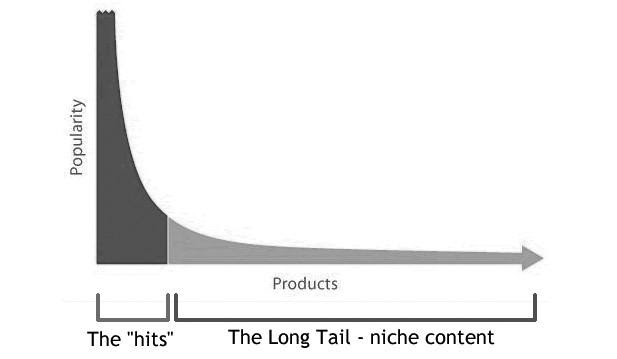Why Alexa Skill Publishers Must Master Skill Store Optimization and User Acquisition
 Editor’s Note: This is a guest opinion column by Voice & You founder Alexis Hue.
Editor’s Note: This is a guest opinion column by Voice & You founder Alexis Hue.
A lot of Alexa skills publishers are hoping to meet large audiences and then successfully monetize. However, the intrinsic characteristics of the skill store mean that to be successful, those publishers need to take the matter of skill distribution on their hands. Here is why.
The Long-Tail Effect
The long-tail concept was first been popularized by Chris Anderson in 2004. If you are not familiar with the concept, it introduces the fact that e-commerce websites like Amazon are giving more visibility to the bottom of the catalog. Therefore Amazon helps to increase the sales of historically less popular items, which in a non-digital world would have no chance of being displayed to potential buyers due to shell space restrictions.
 Music is a great analogy to understand the long-tail effect. As there is a demand for everything, a digital store allowing distribution is an excellent opportunity for “long-tail” or “non-hit” artists or music genres. If you consider that the mobile stores (App Store and Play Store) and the Alexa skill store are an emanation of websites like Amazon, one could argue that an app or skill buried at the bottom of the catalog would benefit from the positive effect of the long tail. As our analysis below highlights, a few factors are refuting the positive effects of the long tail for Alexa skills.
Music is a great analogy to understand the long-tail effect. As there is a demand for everything, a digital store allowing distribution is an excellent opportunity for “long-tail” or “non-hit” artists or music genres. If you consider that the mobile stores (App Store and Play Store) and the Alexa skill store are an emanation of websites like Amazon, one could argue that an app or skill buried at the bottom of the catalog would benefit from the positive effect of the long tail. As our analysis below highlights, a few factors are refuting the positive effects of the long tail for Alexa skills.
Non-Recurrence
In music, recurrence does occur: fans of a particular type of music or artist will purchase the latest release or the live album. For most of the skills today in the skill store, the case is very different: how many weather, grocery list, or meditation skills do users really use? There are exceptions, such as games or sound skills, but this is not the majority. Most of the categories have winner-takes-most attributes.
The skill store – just like mobile stores – is a monopoly. For Alexa users, it is the by-default place to look and find skills, and there is no way (for now) to use a different store. Also, when looking closely, you may find that Amazon itself is editing some of the most used skills. If we take the weather category again: see who is coming up when you ask for a “weather skill.”
 And the list goes on: Amazon Music, Amazon Storytime, Key by Amazon…etc. As a third party publisher, the risk that the company controlling the store release a competing skill does exist. This is not specific to the skill store, though: look at the map or podcast apps in the Play or App Store or those rumors regarding new Apple services.
And the list goes on: Amazon Music, Amazon Storytime, Key by Amazon…etc. As a third party publisher, the risk that the company controlling the store release a competing skill does exist. This is not specific to the skill store, though: look at the map or podcast apps in the Play or App Store or those rumors regarding new Apple services.
Curation and the Store Algorithm
Just like e-commerce websites and app stores, the skill store display items in two ways: editorial display and category or keyword-based display. Humans manage the first one, and like with any human interaction, it is possible to imagine that privileges or partnerships improve your chances of being featured. I’m confident that meritocracy mostly prevails though and that the few exceptions – if any – are of minor effect.
The second way of displaying skills (by category or keyword) is based on an algorithm and is a bit more complicated. The algorithm takes into account a variety of factors such as the volume of enablements, ratings, or retention and keeps evolving. Like in the early days of the mobile stores, using some black-hat or grey-hat tricks could help game the algorithm and manipulate the rankings, leaving meritocracy behind.
What is commonly agreed, though, is that the impact of being featured – by humans or the algorithm – can propel a skill to a new dimension that publishers and developers could only hope for.
What It Means
On one side, the Alexa skill store allows access to a broad audience and offers the possibility for skills to become a (financial) success. On the flip side, it would appear that the chances of success are mostly lying in the hands of Amazon. With increased competition and the winner-takes-most attributes of the skill store, the picture is losing some of its attractiveness.
One of the common sayings within the voice community is that “if you only build it, they won’t come.” If we take the mobile world, no one today would think of launching a new app without some form of marketing efforts behind it. Why should voice be so different? While admittedly at different ages and scales, the voice and mobile stores do share many attributes.
Blaming the lack of users for a given skill on the skill store dynamics is one thing, but it doesn’t help. It is the responsibility of skill publishers to master the marketing of their skills. As the saying goes, “hope is not a strategy.” If publishers want to be successful, they have to take the matter of skill marketing in their hands.
The Need for an Alexa Marketing Strategy
Driving a successful marketing strategy for an Alexa skill is rather complicated. At Voice & You, we like to divide it into several areas and identify the various leverages available to Alexa skill publishers and help move their skills from the bottom of the store. Word of mouth and virality is extremely difficult to master and not applicable to all skills. Few elements that could help you are high brand awareness, an inherently social skill (ex: multiplayer gaming) on top of which you could build acquisition features such as “invite a friend.” To the best of our knowledge, it doesn’t seem that any skill has achieved this (yet).
Skill store optimization (SSO) means getting a skill ranked top on its most important keywords and converting the visitors of the skill page to skill users. There are several parameters at the publisher’s disposal, such as skill name, keywords, icon, meta-description, ratings…etc. No parameter alone will do it: publishers need to play on all and keep testing and optimizing. There are different types of SSO strategies, from purely defensive to offensive ones. What all publishers should nevertheless keep in mind is that there can’t be any marketing strategy for an Alexa skill without SSO.
There’s also user acquisition, the act of gaining new users for your service. When it comes to Alexa skills, user acquisition is the sum of efforts designed around generating enablement and first launch, usually achieved by running advertising campaigns. There are several ways to do this:
- Using one’s non-voice inventory like for example own website, Facebook page, or newsletter
- Using ones’ voice inventory and run cross-promotions of skills (for publishers having several skills)
- Using external inventory such as running ads on Facebook or Google for example
The challenge is that in most cases, publishers can only advertise on non-voice media, and bridging the gap between those media and your Alexa skill is very complex. That’s when a tool like Voxalyze, the Voice Measurement Partner we are associated with, comes handy. Such a tool is attributing new users to a given source/medium/campaign and provides marketers with a “source of truth” for calculating the ROI of marketing campaigns.
The Takeaway
The skill store for all the benefits it offers publishers is far from being perfect. It is a competitive place, and one can only expect the competition between skills for visibility to become more intense, making it then harder to achieve “hit” skill status. To succeed in that environment, publishers need to secure some competitive advantage when it comes to marketing their skills, just like it is the case with websites mobile apps. Skill Store Optimization and User Acquisition are two pillars on which to build that competitive advantage.








